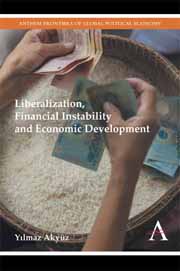Book contents
- Frontmatter
- Dedication
- Contents
- Introduction
- PART ONE LIBERALIZATION, STABILITY AND GROWTH
- Chapter I Financial Liberalization: The Key Issues
- Chapter II Managing Financial Instability in Emerging Markets: A Keynesian Perspective
- Chapter III From Liberalization to Investment and Jobs: Lost in Translation
- Chapter IV Exchange Rate Management, Growth and Stability: National and Regional Policy Options in Asia
- Chapter V Reforming the IMF: Back to the Drawing Board
- PART TWO THE GLOBAL ECONOMIC CRISIS AND DEVELOPING COUNTRIES
Chapter IV - Exchange Rate Management, Growth and Stability: National and Regional Policy Options in Asia
from PART ONE - LIBERALIZATION, STABILITY AND GROWTH
- Frontmatter
- Dedication
- Contents
- Introduction
- PART ONE LIBERALIZATION, STABILITY AND GROWTH
- Chapter I Financial Liberalization: The Key Issues
- Chapter II Managing Financial Instability in Emerging Markets: A Keynesian Perspective
- Chapter III From Liberalization to Investment and Jobs: Lost in Translation
- Chapter IV Exchange Rate Management, Growth and Stability: National and Regional Policy Options in Asia
- Chapter V Reforming the IMF: Back to the Drawing Board
- PART TWO THE GLOBAL ECONOMIC CRISIS AND DEVELOPING COUNTRIES
Summary
Introduction
The exchange rate has become a growing focus of attention in the recent policy debate in developing countries. This is due mainly to two reasons. First, with increased emphasis placed on export-led growth and the dismantling of tariff and nontariff barriers, the role of the exchange rate in growth and development has gained added importance. Drawing on the experience of late industrializers in East Asia, competitive and stable exchange rates have come to be seen as a key ingredient of successful industrialization.
Second, with rapid liberalization of the capital account in developing countries and the growing size and speed of international capital flows, the impact of exchange rate swings on economic activity has undergone a fundamental transformation. Currency movements no longer affect economic activity simply by leading to expenditure switching between domestic and foreign goods, as assumed in the traditional analysis. Their impact on the economy operates mainly through private balance sheets because of growing dollarization of assets and liabilities. Since dollarization is almost always associated with widespread currency and maturity mismatches, exchange rate swings tend to generate windfall losses or gains, thereby exerting significant influence on spending decisions and the viability of firms and financial institutions. For this reason, swings in exchange rates now tend to generate much greater variations in economic activity than in the past, when the dollarization of private balance sheets was limited.
- Type
- Chapter
- Information
- Liberalization, Financial Instability and Economic Development , pp. 117 - 182Publisher: Anthem PressPrint publication year: 2014



